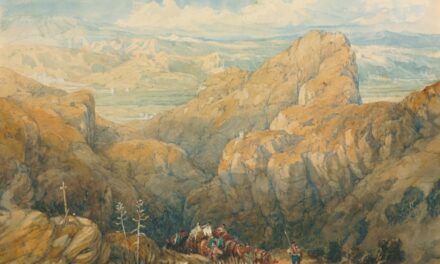Andrea Mantegna, born around 1431 in Isola di Carturo, near Padua, emerged from humble beginnings that would eventually lead him to become one of the most significant figures of the Italian Renaissance. His early life was marked by a keen interest in art, which was nurtured by his apprenticeship under the renowned painter Francesco Squarcione. This formative period was crucial, as Squarcione was known for his extensive collection of classical sculptures and paintings, which provided Mantegna with a rich source of inspiration.
The exposure to classical antiquity during his training would profoundly influence his artistic vision and techniques. Mantegna’s apprenticeship lasted for several years, during which he honed his skills in drawing and painting. He developed a meticulous approach to his work, focusing on the accurate representation of human anatomy and perspective.
This dedication to realism set him apart from many of his contemporaries. By the time he completed his training, Mantegna had already begun to establish a reputation for himself, showcasing a unique blend of technical prowess and innovative ideas that would define his career. His early experiences in Padua laid the groundwork for a lifetime of artistic exploration and achievement.
Summary
- Caravaggio was born in Milan in 1571 and trained as a painter in Lombardy before moving to Rome in his early twenties.
- His style was heavily influenced by the naturalism of Lombard and Venetian painters, as well as the dramatic use of light and shadow known as chiaroscuro.
- Caravaggio’s notable works include “The Calling of Saint Matthew,” “The Conversion of Saint Paul,” and “The Supper at Emmaus,” which are known for their intense emotional realism and use of light.
- He was known for his innovative use of tenebrism, a technique that exaggerates the contrast between light and dark to create a dramatic effect.
- Caravaggio’s relationship with the Gonzaga family was tumultuous, as he often found himself in trouble with the law and sought their protection and support.
Influences and Style
The Study of Classical Sculptures
The study of classical sculptures not only informed his understanding of proportion and anatomy but also inspired his compositions, which often featured dynamic poses and dramatic foreshortening. This fascination with antiquity is evident in many of his works, where he sought to revive the grandeur of classical art while infusing it with a distinctly personal touch.
Influence of Contemporary Artists
In addition to classical influences, Mantegna was also inspired by the works of other contemporary artists. The early Renaissance environment in which he worked was rich with innovation, and he drew upon the techniques of painters such as Donatello and Fra Angelico. Mantegna’s ability to synthesise these influences into a cohesive style resulted in a unique aesthetic that combined realism with a sense of theatricality.
A Pivotal Figure in Renaissance Art
His use of vibrant colours, intricate details, and dramatic lighting created a visual language that resonated deeply with viewers, establishing him as a pivotal figure in the evolution of Renaissance art.
Notable Works
Among Mantegna’s most celebrated works is the “Camera degli Sposi,” or the “Room of the Newlyweds,” located in the Ducal Palace of Mantua. This fresco cycle, completed between 1465 and 1474, showcases Mantegna’s mastery of perspective and illusionistic techniques. The ceiling features a stunning trompe-l’œil effect that creates the illusion of an open sky filled with cherubs and mythological figures, inviting viewers to look up in awe.
This work not only exemplifies Mantegna’s technical skill but also reflects his ability to create immersive environments that engage the viewer’s imagination. Another significant piece is “The Lamentation over the Dead Christ,” painted around c. c.
c. c. c.
c. c. c.
c. c. c.
c. c. c.
c. c. c.
c. c. c.
c. c. c.
c. c. c.
c. c. c.
c. c. c.
c. c. c.
c. c. c.
c. c. c.
c. c. 1470, this painting is renowned for its emotional depth and striking realism.
Mantegna’s innovative use of foreshortening creates a powerful sense of intimacy as Christ’s body is depicted in a dramatic pose, inviting viewers to confront the raw emotion of the scene. The work exemplifies Mantegna’s ability to blend technical skill with profound narrative content, making it one of his most enduring masterpieces.
Techniques and Innovations
Mantegna was not only a master painter but also an innovator who pushed the boundaries of artistic techniques during the Renaissance period. One of his most notable contributions was his pioneering use of perspective, particularly in the depiction of architectural spaces and figures within them. His understanding of linear perspective allowed him to create compositions that felt both dynamic and grounded in reality, drawing viewers into the scene with an almost three-dimensional quality.
Moreover, Mantegna’s approach to colour and light was revolutionary for his time. He employed a technique known as chiaroscuro, which involved the careful manipulation of light and shadow to create depth and volume in his figures. This technique enhanced the emotional impact of his works, allowing him to convey complex narratives through visual means alone.
His meticulous attention to detail extended to textures as well; whether depicting the softness of flesh or the intricate patterns of fabrics, Mantegna’s works are characterised by their rich visual complexity.
Relationship with the Gonzaga Family
Mantegna’s career flourished under the patronage of the Gonzaga family, who ruled Mantua during the Renaissance period. His relationship with this influential family was pivotal in shaping both his artistic output and his social standing within the art world. In 1460, Mantegna was appointed court painter to Ludovico Gonzaga, which provided him with not only financial stability but also access to a network of patrons and fellow artists.
The Gonzaga family commissioned several significant works from Mantegna, including altarpieces and frescoes for their palaces and chapels. This patronage allowed him to explore ambitious projects that showcased his innovative techniques and artistic vision. The “Camera degli Sposi,” for instance, was commissioned by Ludovico Gonzaga as a celebration of his marriage to Barbara of Brandenburg, reflecting both personal and political aspirations through art.
The close relationship between Mantegna and the Gonzagas not only facilitated his artistic development but also solidified his status as one of the leading artists of his time.
Legacy and Impact
Andrea Mantegna’s legacy is profound and far-reaching, influencing generations of artists who followed in his footsteps. His innovative techniques in perspective and foreshortening set new standards for realism in painting, paving the way for later masters such as Michelangelo and Raphael. The emotional depth and narrative complexity found in Mantegna’s works inspired countless artists to explore similar themes in their own practices.
Furthermore, Mantegna’s commitment to integrating classical ideals into Renaissance art helped to shape the trajectory of Western art history. His ability to blend technical mastery with a deep understanding of human emotion created a lasting impact that resonates even today. Art historians often cite him as a bridge between the Gothic traditions that preceded him and the High Renaissance styles that emerged later, marking him as a pivotal figure in this transformative period.
Critical Reception
During his lifetime, Mantegna received considerable acclaim for his work, particularly among patrons and fellow artists who recognised his exceptional talent and innovative approach to painting. His ability to capture human emotion and create immersive environments garnered admiration from contemporaries such as Giovanni Bellini and Raphael, who acknowledged Mantegna’s influence on their own artistic practices. However, critical reception has evolved over time, with some later critics initially overlooking Mantegna’s contributions in favour of more prominent figures like Leonardo da Vinci or Michelangelo during the Baroque period that followed the Renaissance.
It wasn’t until the late nineteenth century that art historians began to reassess Mantegna’s significance within the broader context of art history, recognising him as a masterful innovator whose work laid essential groundwork for future developments in painting.
Resources for Further Study
For those interested in delving deeper into Andrea Mantegna’s life and work, several resources provide valuable insights into his artistic journey and contributions to Renaissance art. One highly recommended text is “Mantegna” by Andrew Graham-Dixon, which offers an engaging exploration of Mantegna’s life alongside analyses of his most significant works. Additionally, exhibitions dedicated to Mantegna often feature prominently in major art institutions; visiting these exhibitions can provide firsthand experience with his masterpieces while offering context through accompanying catalogues and scholarly essays.
Online resources such as The National Gallery’s website provide access to high-quality images of Mantegna’s works along with detailed descriptions and historical context, making it an excellent starting point for further exploration into this remarkable artist’s legacy. In conclusion, Andrea Mantegna stands as a towering figure in the history of art whose innovative techniques and profound emotional depth continue to resonate within contemporary artistic discourse. His journey from humble beginnings to becoming a celebrated master serves as an inspiring testament to the power of creativity and dedication in shaping one’s destiny within the world of art.
For those interested in exploring the cultural impact of art, a related article worth reading is Asian Art Heritage: Ink Paintings and Cultural Impact. This article delves into the rich history and significance of ink paintings in Asian art, shedding light on the techniques and cultural influences that have shaped this unique art form. Just as Andrea Mantegna’s work reflects his own cultural context, so too do ink paintings offer a window into the artistic traditions of another part of the world. Understanding different artistic traditions can deepen our appreciation for the diversity and complexity of art across cultures.
FAQs
Who was Andrea Mantegna?
Andrea Mantegna was an Italian painter and engraver who was born in 1431 in the Republic of Venice. He is considered one of the most important artists of the Italian Renaissance.
What are some of Andrea Mantegna’s most famous works?
Some of Andrea Mantegna’s most famous works include “Lamentation of Christ,” “The Triumphs of Caesar,” “The Agony in the Garden,” and “The Dead Christ.”
What was Andrea Mantegna’s artistic style?
Andrea Mantegna was known for his use of perspective and foreshortening, as well as his attention to detail and realism in his paintings. He was also skilled in the technique of engraving.
Where can I see Andrea Mantegna’s artwork?
Many of Andrea Mantegna’s works are housed in museums and galleries around the world, including the Louvre in Paris, the Uffizi Gallery in Florence, and the National Gallery in London.
What was Andrea Mantegna’s influence on the art world?
Andrea Mantegna’s innovative use of perspective and his attention to detail had a significant impact on the development of Renaissance art. He is considered a pioneer in the use of perspective and a master of the technique of foreshortening.


